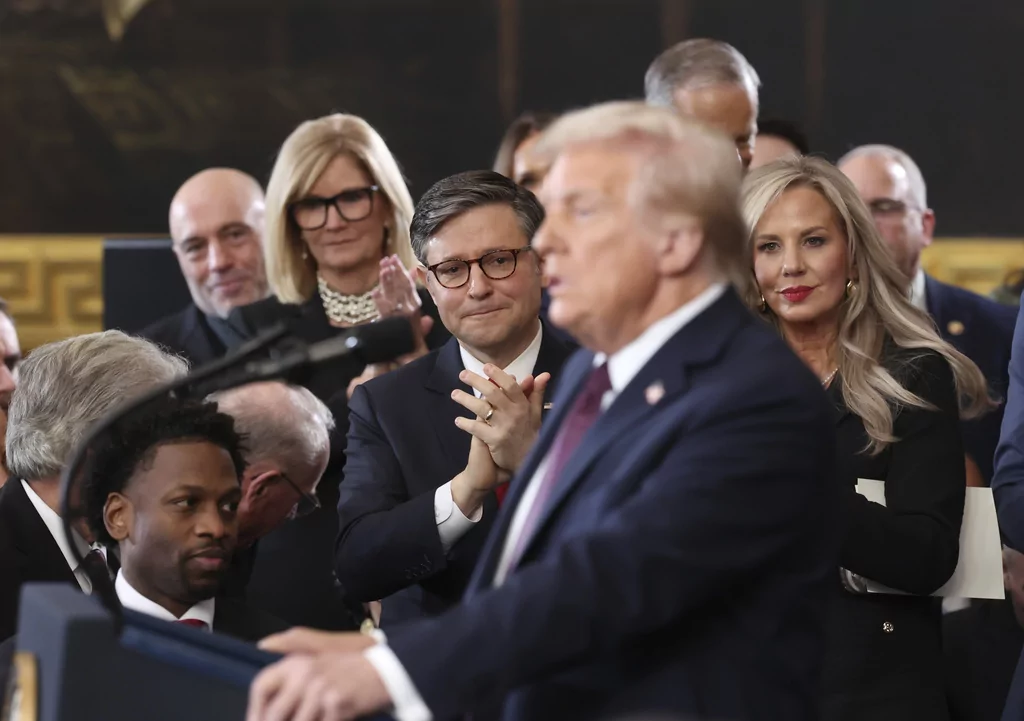

The House will attempt to pass a budget resolution this week that unlocks President Donald Trump’s agenda, setting up a pivotal test for Speaker Mike Johnson (R-LA) as he battles with the Senate over who is taking the lead.
Republicans have been fighting for months, across chambers and ideological divides, over whether reconciliation, a process that allows the Senate to bypass the filibuster, should be completed with one bill or two.
Johnson wants to sweep border security and defense into an all-encompassing bill that includes tax reform, but Senate leadership has insisted on handling tax cuts later in the year.
WHAT IS DOGE? WHAT TO KNOW ABOUT THE DEPARTMENT OF GOVERNMENT EFFICIENCY
After the House found itself “stuck in the mud” on its budget resolution this month, an impasse centered on spending cuts, the Senate ultimately decided to leapfrog the House, adopting a border-centric framework on Friday after a late-night voting marathon.
Now, the House plans to bring its single-bill approach to the floor on Tuesday, presenting Johnson with his biggest obstacle yet. He managed to usher the blueprint through the House Budget Committee earlier this month, but a vote before the entire chamber threatens to derail his progress, as he can only afford to lose a single Republican thanks to his narrow majority.
Standing in the way of approving the resolution are centrist holdouts concerned with the level of spending cuts Johnson negotiated with the conservative Freedom Caucus and how, if at all, it will affect Medicaid. Even members of that conservative caucus are not entirely sold on the resolution as it gets brought to the floor.
Rep. Chip Roy (R-TX), a fiscal hawk who pushed Johnson to accept $2 trillion in cuts, told the Washington Examiner that the “devil is in the details” and it is still up in the air whether the resolution will be adopted this week.
“I think there are some spending cutters like me who still have concerns,” Roy said. “I do. I voted for it out of committee, and I’m proud to have voted out of committee, but I still need to see — as I was alluding to, there’s a lot of moving parts.”
Medicaid on the chopping block
The House’s budget resolution would renew $4.5 trillion of Trump’s expiring tax cuts from 2017 coupled with $2 trillion in spending offsets.
Under the 10-year plan, the House Energy and Commerce Committee would have to reduce spending to programs it oversees by $880 billion, making a rollback of Medicaid very likely.
Republican senators have indicated they are against steep cuts to Medicaid, dimming the resolution’s chances in the upper chamber.
In the House, eight Republicans who are Hispanic or represent districts with significant Latino populations wrote a letter last week urging Johnson not to slash the entitlement, noting their constituents rely heavily on the program and its potential impact on working-class families.
“Slashing Medicaid would have serious consequences, particularly in rural and predominantly Hispanic communities where hospitals and nursing homes are already struggling to keep their doors open,” the lawmakers wrote.
EXPERTS WARN THAT TRUMP’S FOREIGN AID PIVOT COULD BE A BOON FOR CHINA
Johnson is navigating the fight over entitlements with the 2026 elections in the back of his mind. He cannot adopt a resolution without the support of hard-liners in his conference, but he also must protect the vulnerable incumbents who delivered their House majority in November.
House Republicans’ campaign arm, chaired by Rep. Richard Hudson (R-NC), has projected confidence that the GOP can maintain and even grow their majority next year. But Johnson is also facing political headwinds: The midterm elections historically mean losses for the party in control of the White House.
Johnson survives first bumps in the road
The road to Tuesday’s expected vote was long and arduous, with leadership and members of the Freedom Caucus holding repeated meetings to hammer out the budget resolution.
Like Senate Republicans, House conservatives were pushing for a two-bill approach that delivers Trump a win on border and defense funding before entering into the more difficult tax negotiations. But the Freedom Caucus still engaged with Johnson on his one-bill plan, securing the very concessions that have turned off GOP centrists.
The blueprint is just the first step to actually enacting Trump’s agenda and only directs committees to start crafting legislation at certain spending levels. The House and Senate need to agree on the same budget resolution to start the process, and then the hiccups become whether each chamber can agree on the finer details of the bill.
The House’s budget resolution would require between $1.5 trillion and $2 trillion in cuts, as well as a $4 trillion debt ceiling increase — two provisions meant to win over the Freedom Caucus. Trump himself came out on Wednesday and endorsed the plan, arguing it “implements my FULL America First Agenda, EVERYTHING, not just parts of it!”
But he has also sent mixed signals to congressional Republicans. On Friday, he said he does not care if his agenda is passed in one, three, or even 10 bills.
“As long as we get them all added up and it’s the same thing,” Trump told radio host Brian Kilmeade. “And, you know, I think we’re in very good shape.”
There is a dispute between the two chambers over whether to make the expiring tax provisions permanent, and the way to calculate their cost.
As far as the Freedom Caucus, Roy warned against budget “gimmicks” that obscure the true level of cuts.
“There’s going to be some questions about whether we achieve cuts, make sure that people don’t try to play gimmicks,” Roy said. “There’s a lot of work to be done to get there, but the framework, I think, is a pretty solid start by saying that we’re basically attaching the accomplishment of getting spending cuts to tax cuts. And I think that was an important statement, an important framework, for Republicans to adopt.”
Roy said he is still a supporter of the two-bill approach but will get behind one “provided we get what we need to get done.”
“So now, the question is whether the House and the Senate will come together to do that,” the Texas congressman said. “I think there’s general agreement on most of the things we want to achieve. It’s just going to be, the devil will be in the details.”
Hovering over the reconciliation process is the matter of appropriations, with funding set to expire on March 14. Top appropriators in the House and Senate are still in negotiations, with Senate Appropriations Chairwoman Susan Collins (R-ME) telling reporters last week that discussions were “not going well” as Democrats look for assurances that the president will adhere to Congress’ authority to set funding levels.
Roy thinks a delay in getting the toplines for appropriations could negatively affect the GOP negotiations over reconciliation.
“If we’re not seeing commitments, we’re not seeing the top line numbers on the appropriations side … then we’re going to have potential problems, because a lot of conservatives are gonna say, ‘Wait a minute, you’re asking me to throw another — $100 billion in these programs. What are you doing in March?”
Democrats ramp up pressure on House GOP
Democrats have limited political power with Republicans holding a trifecta, but that has not stopped them from amping up their rhetoric against Trump and the GOP’s budget proposals.
On Tuesday, the House Majority PAC accused vulnerable Republicans of “abandoning their constituents” with the possible cuts to Medicaid. In a memo, the group listed battleground districts and their GOP representative, followed by the number of Medicaid enrollees and the percentage of children on the program in the district.
“The cuts currently pushed by House Republicans will be a defining issue in 2026,” the memo stated, promising the PAC “will hold them accountable for abandoning their constituents to further enrich the wealthiest Americans and biggest corporations.”
Democrats, fresh off their 2024 election losses, have also set their sights on Elon Musk, the X mogul and head of the Department of Government Efficiency, as they focus on the spending cuts.
Many Democratic lawmakers have argued they need to do better at “connecting the dots” in terms of messaging and show what Trump and Musk are doing “behind the curtain.”
CLICK HERE TO READ MORE FROM THE WASHINGTON EXAMINER
“Their objective, actually, is to pass massive tax cuts for billionaires, donors, and their wealthy corporations. And then … stick working-class Americans with the bill by slashing and burning things like Medicaid to the ground,” House Minority Leader Hakeem Jeffries (D-N.Y.) said in an interview with MSNBC’s Nicolle Wallace this month.
Democratic leadership held a virtual caucus meeting with members last week, with Jeffries encouraging lawmakers to continue hammering Trump in their districts while on recess. Minority Whip Katherine Clark (D-MA) emphasized that it will be important for Democratic members to be in attendance this week given the House’s razor-thin margins as well.





